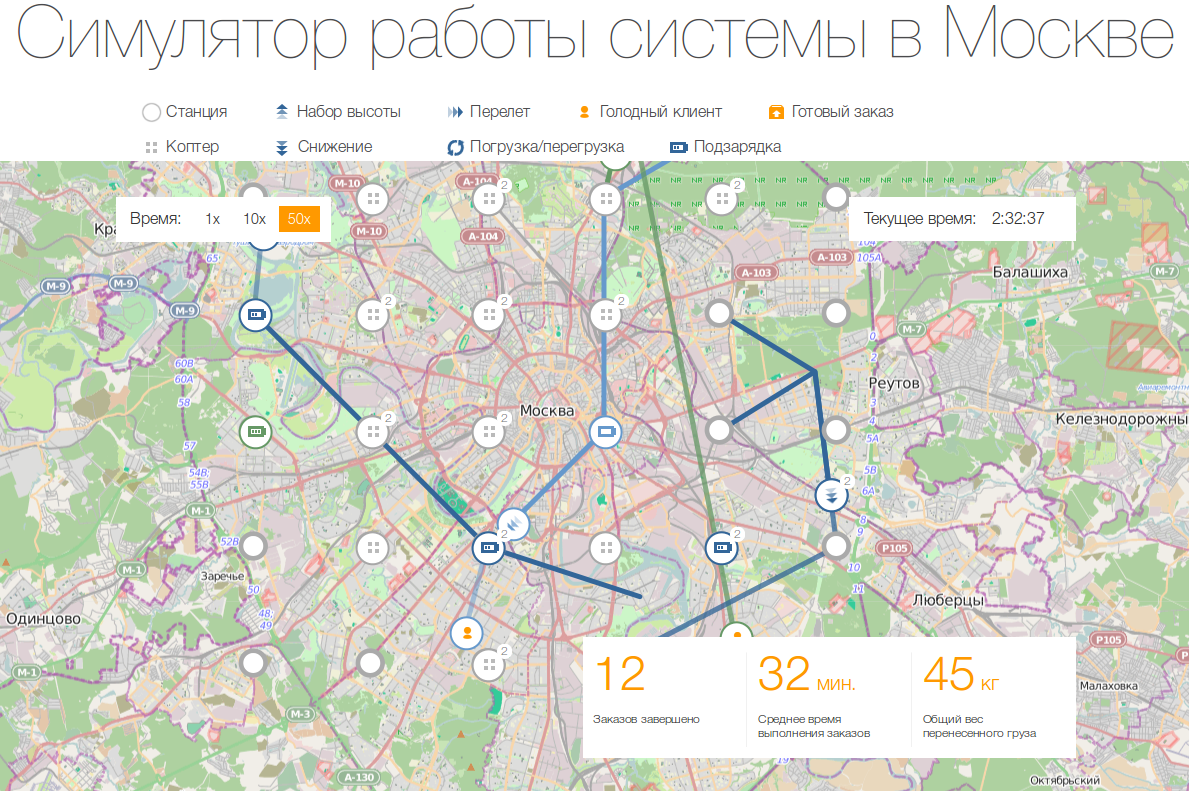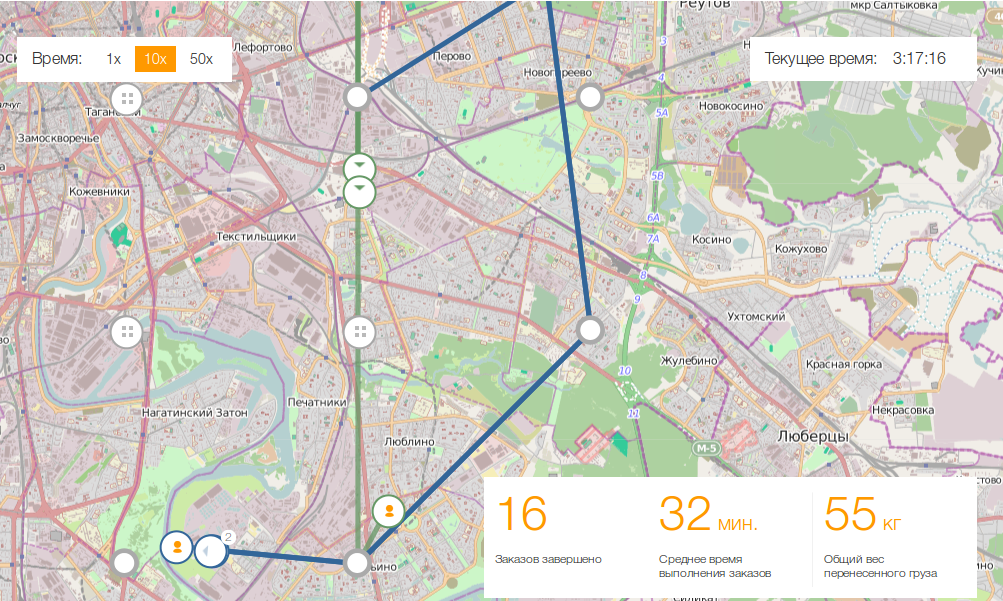Cargo Delivery Simulator Using Quadrocopter Swarm
Hello!
In the copter industry, everyone is now actively engaged in the development of hardware and software for this hardware, but I wanted to start exploring the issue of commercial use of copters from a system that allows us to automate and scale up their use in the future.
Therefore, the next goal appeared - taking into account modern TTX of quadrocopters, to show the possibility or impossibility of fast cargo delivery with their help, simulating such delivery on the example of a large city.

')
For example, they took Moscow and covered it with a grid of charging stations / transplants with a step of 5 km.
The conditions in the simulator world are as follows:
The quadcopter is used with the following TTX:
In the simulator flows real time, against which everything is happening. Once in 10 minutes orders appear in an arbitrary place in Moscow. An order is a place where a hungry customer and a restaurant are standing, where they have already prepared a lunch of random mass for him at a given interval. After receiving information about the order, the system calculates the necessary parameters of the route receipt - the number of required drivers, from which stations they should be taken, which route they should fly. After this, the required copters or a copter, having received information into their on-board computer, begin the route, take the lunch and carry it to the user.
If the kopter understands that the current charge is not enough to reach the user plus return to the base, then he flies to the nearest base towards the user. At the station, the copter overloads the order for a free copter, but it remains to be charged.
Having written all this logic, we started the simulator and began to observe. At first, everything went fine and the average order delivery time was around 25 minutes, but then it began to grow. Then suddenly one of the copters disappeared in Butovo. This alarmed, it turned out he crashed, since all the stations were filled and he did not have enough charge to fly to free.
After seeing this behavior, we also added to the work logic the reservation of places at the stations, now the copters, building their route, reserved places at the stations in advance, in order not to remain without a seat when the charge is already close to zero.
If the mass of the order is more than one copter can lift, then several copters perform it, flying together, though sometimes it turns out that they arrive at the user at different intervals, but for the time being we will leave it as a feature.

Delivery of two heavy orders by two copters
After that, the next task was to reduce the average delivery time, which was still growing with time. To do this, the work was done by adding a rearrangement of copters from unnecessarily filled stations to empty ones. Over time, the copters grouped together at some random stations, leaving others empty — as a result, the average delivery time increased. As soon as the logic was corrected, even after two simulation days, the delivery time was still within 30-40 minutes.

Rearrangement of copters from occupied stations to free ones
You can watch the simulator live here - http://karlssonproject.com/#map
The statistics block shows the number of orders delivered, the average delivery time and the total mass of goods transported. Below are two plates with detailed information on all orders and Copters with an indication of all the changing parameters.
What is not taken into account now in the simulator:
Final assumptions:
Even on existing copters, it is possible to make a system for the automatic delivery of light loads, and later, with an increase in battery capacity, the characteristics of the screw-motor group, the number of required stations will only decrease, and the capacity of the entire system will grow.
PS
In fact, this simulator is the first part of the project to deliver food to the copters. Now we, having written the software part of the project, proceed to creating the autopilot of the kopter and are looking for interested geeks, with whom we will write anartificial intelligence autopilot.
For details, welcome to karlssonproject.com
In the copter industry, everyone is now actively engaged in the development of hardware and software for this hardware, but I wanted to start exploring the issue of commercial use of copters from a system that allows us to automate and scale up their use in the future.
Therefore, the next goal appeared - taking into account modern TTX of quadrocopters, to show the possibility or impossibility of fast cargo delivery with their help, simulating such delivery on the example of a large city.

')
For example, they took Moscow and covered it with a grid of charging stations / transplants with a step of 5 km.
The conditions in the simulator world are as follows:
- Distance between stations - 5 km
- Initial distribution of copters - 2 per station (except for the most extreme stations)
- Station capacity - 4 copter
- The frequency of the appearance of the order - once every 10 minutes
- The interval of allowable order weights - from 1 to 8 kg
The quadcopter is used with the following TTX:
- Flight speed - 16 m / s
- Flight level - 200 m
- Flight time without load - 30 min
- Flight time with a full load of 4kg - 10 min
- The discharge rate of the battery is linear relative to the weight of the load.
- Full charge time - 20 minutes
- Rate of climb while lowering \ set - 6 m \ c
In the simulator flows real time, against which everything is happening. Once in 10 minutes orders appear in an arbitrary place in Moscow. An order is a place where a hungry customer and a restaurant are standing, where they have already prepared a lunch of random mass for him at a given interval. After receiving information about the order, the system calculates the necessary parameters of the route receipt - the number of required drivers, from which stations they should be taken, which route they should fly. After this, the required copters or a copter, having received information into their on-board computer, begin the route, take the lunch and carry it to the user.
If the kopter understands that the current charge is not enough to reach the user plus return to the base, then he flies to the nearest base towards the user. At the station, the copter overloads the order for a free copter, but it remains to be charged.
Having written all this logic, we started the simulator and began to observe. At first, everything went fine and the average order delivery time was around 25 minutes, but then it began to grow. Then suddenly one of the copters disappeared in Butovo. This alarmed, it turned out he crashed, since all the stations were filled and he did not have enough charge to fly to free.
After seeing this behavior, we also added to the work logic the reservation of places at the stations, now the copters, building their route, reserved places at the stations in advance, in order not to remain without a seat when the charge is already close to zero.
If the mass of the order is more than one copter can lift, then several copters perform it, flying together, though sometimes it turns out that they arrive at the user at different intervals, but for the time being we will leave it as a feature.

Delivery of two heavy orders by two copters
After that, the next task was to reduce the average delivery time, which was still growing with time. To do this, the work was done by adding a rearrangement of copters from unnecessarily filled stations to empty ones. Over time, the copters grouped together at some random stations, leaving others empty — as a result, the average delivery time increased. As soon as the logic was corrected, even after two simulation days, the delivery time was still within 30-40 minutes.

Rearrangement of copters from occupied stations to free ones
You can watch the simulator live here - http://karlssonproject.com/#map
The statistics block shows the number of orders delivered, the average delivery time and the total mass of goods transported. Below are two plates with detailed information on all orders and Copters with an indication of all the changing parameters.
What is not taken into account now in the simulator:
- Weather conditions - the wind is always calm. No hurricanes and showers. After some time we will add, on the basis of Yu-Z, wind roses in Moscow.
- Dangerous zones - in real life in the memory of the copter there will be dangerous points with a given radius, where you should not fly into, and now in the simulator they all fly directly
- Tall buildings - now the constant height of the train is set at 200 m, however, in reality, the ship will use the map of buildings from Google and fly just above the roofs of all the buildings on the route. This will save the charge to climb 200 meters where there is enough 50 or, on the contrary, to rise higher in the City, Metropolis or Ostankino tower area.
Final assumptions:
Even on existing copters, it is possible to make a system for the automatic delivery of light loads, and later, with an increase in battery capacity, the characteristics of the screw-motor group, the number of required stations will only decrease, and the capacity of the entire system will grow.
PS
In fact, this simulator is the first part of the project to deliver food to the copters. Now we, having written the software part of the project, proceed to creating the autopilot of the kopter and are looking for interested geeks, with whom we will write an
For details, welcome to karlssonproject.com
Source: https://habr.com/ru/post/219141/
All Articles